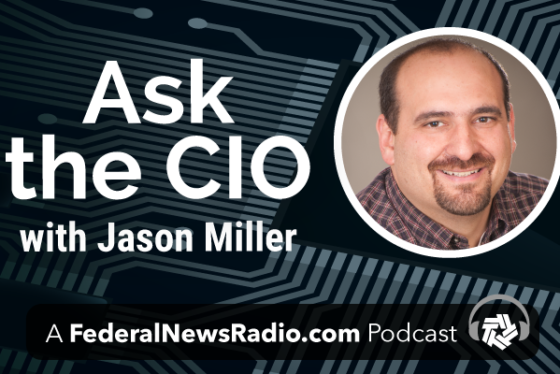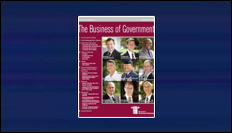Hubbard Radio Washington DC, LLC. All rights reserved. This website is not intended for users located within the European Economic Area.
Technology
-
Infosecurity.com reports on a survey that founds most cybersecurity team members said they need more information about case studies and best practices.
December 28, 2010 -
The U.S. isn\'t the only country preparing for a future cyber attack.
December 28, 2010 -
McAfee\'s Dave Marcus discusses what the look out for next year in cybersecurity.
December 28, 2010 -
December 27th and December 29th, 2010 Hear from a varied group of leaders, innovators, practitioners, and thinkers, who offer models to follow, provide insights that infuse theory to practice, and pave the way to shaping the business of government. Our guests will include Vice Admiral Jack Dorsett, Dr. Bobby Braun, Dr. David McClure, Richard Spires, Clarence Carter, and Russ Mills as they discuss public management challenges and innovations.
December 27, 2010 -
Federal Aviation Administration safety inspectors at the North Pole certified Santa One, the reindeer-powered sleigh piloted by Santa Claus, prior to its 2010 Christmas Eve delivery mission. Santa One - they report - is outfitted with new satellite-based NextGen technology, that allows Santa to deliver more toys to more children with improved safety and efficiency. Rudolph\'s nose has been outfitted with avionics that can broadcast Santa One\'s position to air traffic controllers around the world with improved accuracy. FAA Administrator Randy Babbitt says Santa\'s cockpit display is improved to help improve his situational awareness. Even as energy-efficient as the reindeer-powered sleigh already is, officials say NextGen technologies have further reduced Santa One\'s carbon hoofprint. Shorter, faster routings mean the reindeer consume less hay.
December 27, 2010 -
The department of the Interior has approved the Crescent Dunes Solar Energy Project in Nevada. It\'s the ninth large-scale solar facility started as part of the administration\'s initiative to encourage the development of renewable energy on U.S. public lands. The plant will use concentrated solar thermal \"power tower\" technology to contribute 485,000 megawatt hours of renewable energy annually to the Nevada grid. It\'s part of an effort -across the administration - to advance a renewable energy economy. The project is sited on approximately 22-hundred acres administered by the Bureau of Land Management. The Bureau has approved six renewable energy projects on public lands in Nevada - three solar, two geothermal and one wind - along with a long-distance transmission line that will deliver a variety of energy sources to consumers across the western United States.
December 27, 2010 -
U.S. Archivist David Ferriero describes how the National Archives is using online tools to increase public participation.
December 27, 2010 -
Self-proclaimed \"technogeeks\" at the Defense Advanced Research Projects Agency, after determining the nature of the cybersecurity threat, have created programs to tackle them and, most importantly they say, surprise would-be cyber crooks. Officials at DARPA say the agency\'s sole mission since its inception in 1958 has been to prevent technological surprises. Two of the agency\'s recent cybersecurity programs, called CRASH and PROCEED, were created for that purpose. CRASH - the Clean-slate Design of Resilient, Adaptive, Secure Hosts program - seeks to build new computer systems that resist cyberattacks. After successful attacks they learn from the attack, adapt and repair themselves. The program evolved from a workshop DARPA held earlier this year that pulled together experts in cybersecurity and operating-system as well as infectious-disease biologists.
December 27, 2010 -
NASA is one of the federal pioneers of video teleconferencing systems (remember the first broadcasts from space?)…so it\'s no surprise that this agency\'s program managers continue to rely on video conference technology to meet its daily demands for high-quality audio and visual communication among diverse public and private sector communities. \"At NASA, teams at varied locations need a way to engage in timely, technical conversations and collaborate remotely to meet mission-critical goals,\" said NASA\'s Deputy Chief Information Officer Deborah Diaz. NASA -- both Headquarters and its major centers around the country -- uses video teleconferencing for everything from meetings, seminars, major international conferences and face-to-face meetings to quick conversations on pressing issues. The payoff is obvious: more cost-efficient and -effective operations, with savings on facilities as well as meeting planning and logistics. At an Open Government Summit hosted by NASA in the fall of 2010, nearly 60 percent of the participants used electronic tools to \"virtually attend\" the summit. Organizers faced twin challenges of being efficient but also inclusive, while juggling video streaming, cooperative note-taking, online teleconferencing and adapting conversational practices in the room, to bridge the gap between physical and virtual participants. What are they using? NASA Headquarters maintains video teleconferencing systems (ViTS) in multiple configurations, with equipment from vendors including Tandberg, Polycom and LifeSize. The typical ViTS stack includes the ViTS components themselves, additional recording units, PCs and in some cases SmartBoard capability. NASA is in the process of migrating all of its ViTS to have High Definition, digital sign control, and MP3 audio recording capabilities Latest capability improvements include Flash and Windows Media Video streaming via the Web. Users who have a small portable streaming system can view transmissions via computer from anywhere in the world. Some configurations offer MP3 recording capability that lets NASA burn CDs to distribute audio recordings; in others, NASA can use full audiovisual recording capability to capture entire events on Digital Video Disc (DVD) or Blu-Ray. NASA has begun implementing a Voice-Over-IP (VOIP) phone system, too. That will speed the delivery of IP-based desktop video conferencing as the agency phases out ISDN-based systems and will increase ViTS availability to NASA employees while reducing overall costs associated with equipment maintenance, operations, and logistics typical of larger ViTS facilities. \"Technology enables and supports one to thousands of conversations,\" said NASA\'s Chief Technology Officer for IT, Chris Kemp. \"We\'re finding that if we don\'t stand in the way of that conversation, incredible things can happen.\"
December 27, 2010 -
Rep. Mac Thornberry (R-Texas) will lead cybersecurity efforts that cut across committee lines.
December 27, 2010 -
OPM\'s Nancy Kichak explains how the cyber internship works.
December 27, 2010 -
The IBM Center for the Business of Government released a report that highlights best practices for federal financial management.
December 27, 2010 -
Cloud computing began to take center stage in the federal IT community during the last few months of 2010. And Ed Meagher thinks that trend will continue in 2011. Meagher is the former deputy chief information officer at the Veterans Affairs Department and the Interior Department. He’s now vice president of health care strategy at [...]
December 26, 2010 -
The company will provide engineering, security and operations and maintenance services under the Vanguard program. The 10-year contract is one piece of a larger IT consolidation effort State is in the middle of completing.
December 23, 2010
ASK THE CIO

THURSDAYS @ 10 & 2 p.m.
Weekly interviews with federal agency chief information officers about the latest directives, challenges and successes. Follow Jason on Twitter. Subscribe on Apple Podcasts or Podcast One.





